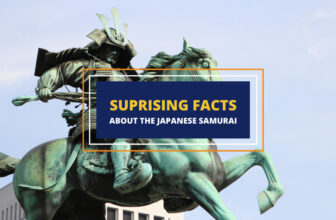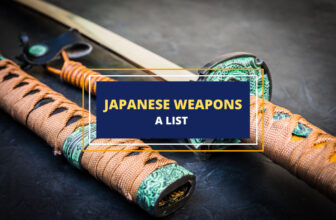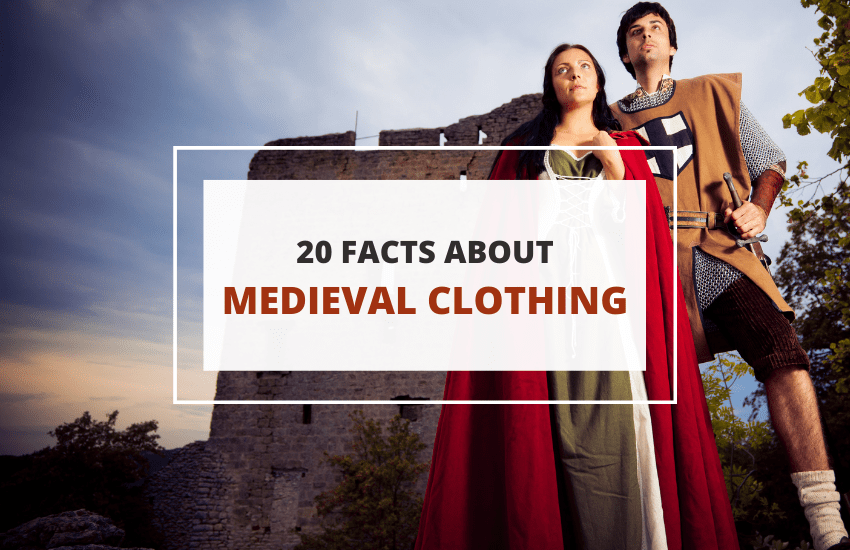
Table of Contents
The Middle Ages is often described as being violent, and plagued with conflicts and diseases, but it was also a period of ingenious human creativity. One aspect of this could be seen in the fashion choices of the medieval period.
Medieval clothing often reflected the status of the wearer, giving us an insight into their daily lives, distinguishing the rich from those less fortunate.
In this article, let’s take a look at the evolution of medieval clothing and how common traits in fashion can be found across the old continent and different centuries.
1. Fashion in the Middle Ages was not very practical.
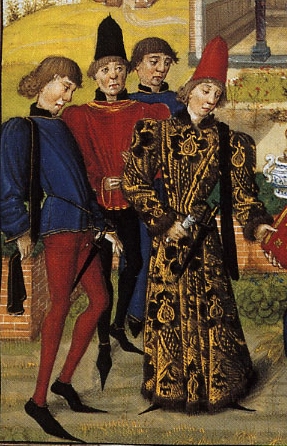
It is almost impossible to imagine that anyone would want to wear many of the clothing items that were worn during medieval times. This is because most of us would find them to be very impractical by our standards. Perhaps the most obvious and striking example of impractical medieval clothing items come from the 14-century clothing of European nobility.
While every period is known for its specific fashion trends, the 14th century was marked by an obsession with long, oversized fashion items. One example of this was extremely pointy shoes, known as crakows or poulaines, that were worn by the nobility across Europe.
The pointy shoes became so impractical that 14th-century French kings prohibited the production of these shoes, hoping that they would be able to stop this fashion trend.
2. Doctors used to wear purple.
It was a common practice in countries like France for doctors and medical workers to wear scarlet or violet clothing that was made from high-quality material. This was especially the case for university professors and people that taught medicine.
The choice of violet is not accidental. Doctors wanted to visually separate themselves from the common folk and indicate that they were highly educated individuals.
While nowadays, wearing purple is often a matter of a fashion statement, during the Middle Ages it was a signal of status and a way to separate the rich from the poor, the important from those deemed less important at the time.
Another curious fact is that in some societies, medieval doctors were not allowed to wear green.
3. Hats were highly sought after.
Hats were very popular, regardless of the social class one belonged to. For example, straw hats were all the rage and continued being in fashion for centuries.
Hats were originally not a status symbol but over time they also started reflecting societal divisions.
We know about their popularity from artworks from the Middle Ages that show people of all classes sporting straw hats.
While workers in the fields would wear them to protect themselves from the scorching heat, members of the upper class wore elaborate straw hats during spring and winter, often decorated with complex patterns and colours.
Even the nobility began wearing them and those who could afford a more elaborate piece would usually invest in straw hats that were more durable and ornamental so that they could also separate themselves from the conventional clothing items worked by members of the lower classes.
4. Highlighting the buttocks was a thing.
This is a rather amusing fact that many do not know about. At one-point, European medieval nobility sported and even encouraged wearing shorter tunics and tighter garments.
The use of shorter and tighter clothes was often done to highlight one’s curves, especially buttocks and hips.
The same fashion trends were not applicable to the peasantry. This trend was particularly famous in England in the 15th century. Although it didn’t remain in all European societies, it returned in later centuries, and we know this from the artworks that display garments of the time.
5. Ceremonial clothing was especially ornamental.
Ceremonial clothing was so special and highly decorated that it would often be created only for one specific religious occasion. This made ceremonial clothing items extremely luxurious and sought after.
Interestingly enough, ceremonial clothing often reflected tradition instead of modernity. While it was often highlighted with striking colors and jewels, it still echoed older clothing traditions that were abandoned and simply not practiced anymore in regular life.
This is what made ceremonial clothing perhaps one of the earliest examples of fashion returning and being reinvented over time. Even today’s ceremonial garments look similar to old trends, but a well-trained eye might be able to spot some echoes of modernity as well.
We see best examples of keeping up with the tradition in religious attire of the Catholic church that has not changed significantly, especially when it comes to the highest echelon of the Vatican during the religious ceremonies.
6. Servants wore multi-colored outfits.
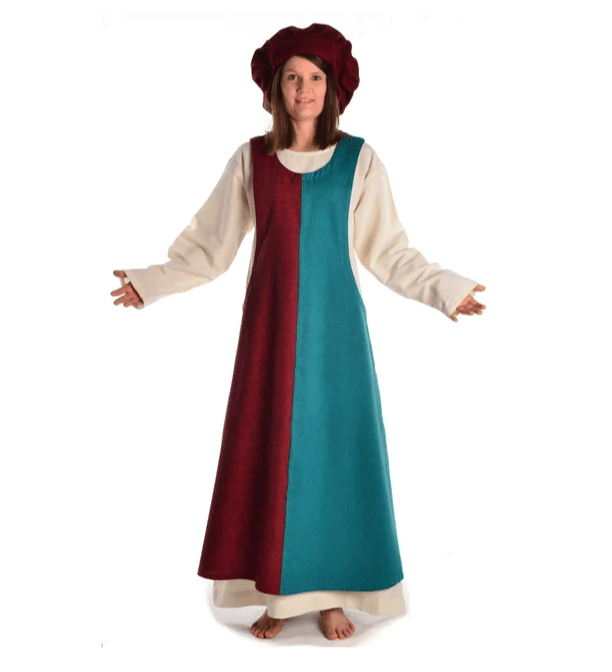
You may have spotted frescoes or artwork depicting servants, singers, or artists wearing multi-colored clothes, known as mi-parti. This clothing was reserved for only the distinguished servants of nobility who were expected to wear them.
Noble houses preferred their servants to reflect the audacity and wealth of the house which is why they had them dress up in vibrant colors that reflected the outfits of their patrons.
The most beloved fashion trend for servants of nobility was to wear gowns or outfits that were vertically split into two halves that contained two different colors. Interestingly, this did not only reflect a common trend, but it was also to send a signal of a rank of a servant and then even the rank of the household itself.
7. Nobility was afraid of the fashion police.
One of the reasons that priests would sometimes be spotted in highly ornamental and decorative clothing items was because it was highly frowned upon to see nobility wearing the same things.
This is why nobility would discard their clothes or even give them away to priests and the Church would then remodel them and turn them into ceremonial clothing. It was simply a sign of weakness for nobility to show that they lacked new attire, and this was a common trait all over Europe.
This was highly practical for the priests because they could use these highly decorative clothing pieces to highlight their high status as a priest and spend fewer resources on religious attire.
8. Everyone loved sheep wool.
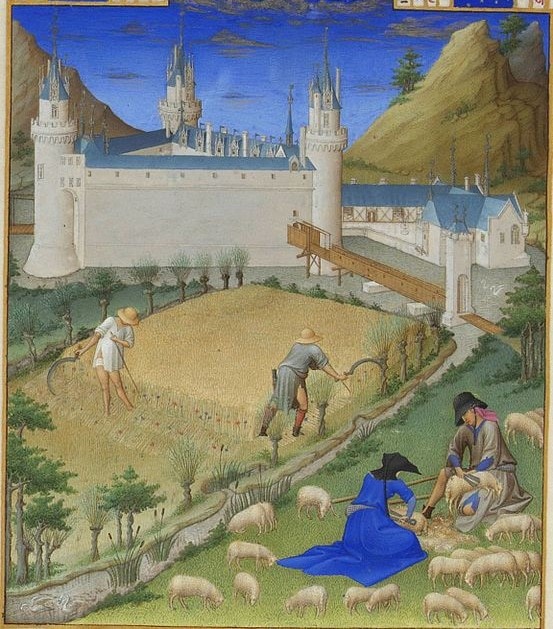
Sheep wool was highly sought after. It was especially loved by those who preferred to wear and dress more modestly. We might think that people of the Middle Ages would regularly wear, white, or grey clothing items but this was not the case.
The easiest and cheapest wool to get was either black, white, or grey. For those with a deeper pocket, colored wool was available. Clothing items made out of sheep wool would be comfortable and warm and we even know that some priests refused to wear elaborate religious attire and opted for humble wool clothing items. Wool was ideal for cold areas of Europe, and it remained popular throughout centuries.
9. Shoes were not a thing for a while.
Another striking feature that many have never heard about is the so-called sock shoes that were popular in Italy around the 15th century. Some Italians, especially the nobility, preferred to wear socks that had soles instead of wearing socks and shoes at the same time.
The sock shoes became such a popular fashion trend that Italians were often seen sporting these while outside of their homes.
Today we know about similar footwear trends where many shoppers prefer to buy footwear that mimics the natural shape of feet. Whatever you think of it, it seems that the Italians did it first, centuries ago.
10. Women’s fashion got minimalistic during the 13th century.
The 13th century saw a sort of a societal decline that was also witnessed in the way fashion items for women were displayed and worn. The 13th-century dress code did not push as much for the audacious vibrant clothing items and textures. Instead, women preferred to opt for more modest-looking dresses and garments – often in earthy tones.
The decoration was minimal and there was not a lot of hype around fashion. Even men started wearing cloth across armor when they would go to battle to avoid their armor reflecting and showing their location to enemy soldiers. This is perhaps why we do not think of the 13th century as the pinnacle of fashion.
11. The 14th century was all about the human figure.
After the fashion flops of the 13th century, there was not much significant development in the fashion world of the medieval times. But the 14th century brought a more audacious taste in clothing. The most notable example of this is the sporting of clothes that were not just supposed to be decorative or ornamental or to make a statement. It was also worn to highlight the shape and the figure of the person that was wearing it.
This comes as no surprise given the fact that the Renaissance was already starting to shape up and concepts of human dignity and virtues began to reappear. Hence, it was not surprising that people felt more encouraged to show their bodies and celebrate their figures after such a long period of hiding them in layers of clothing.
The fashion of the 14th century made the human figure into a canvas over which intricate clothing was applied and celebrated.
12. Italy was an exporter of brands much earlier than you expected.
Italy in the 14th century was already booming with the wave of Renaissance that celebrated the human figure and human dignity. This wave was also reflected in changing tastes and increased demand for clothing items that were made out of higher quality cloth or fabric.
It did not take too long for these tastes to be exported outside of Italy and other European societies started to demand more high-quality clothing items. This is where Italy stepped in, and tailoring garments became a lucrative industry.
Textiles, colors, and the quality of the fabric became not a thing of luxury but a thing of necessity and high demand.
13. Crusaders brought in the impact of the Middle East.
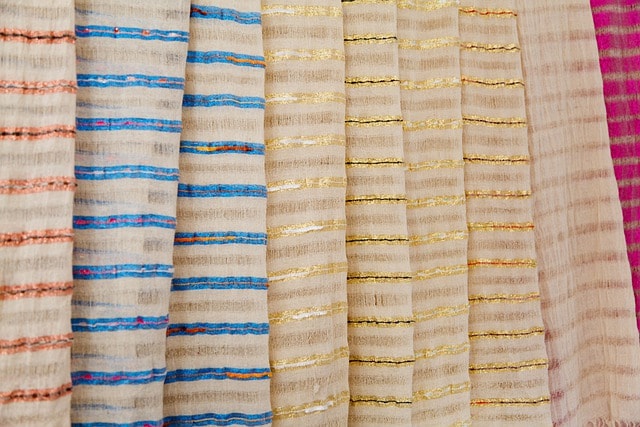
Another little-known fact is that the Crusaders that went to the Middle East during Middle Ages did not just bring the many treasures that they plundered on their way. They also brought back a plethora of clothing items and fabric made out of silk or cotton, dyed with vibrant colors, and ornamented with lace and gems.
This import of clothing and textiles from the Middle East had a monumental impact on the way that peoples taste shifted, causing a rich convergence of styles and tastes.
14. Textile colors did not come for cheap.
Textile colors were rather expensive and as we mentioned many preferred to wear simple garments made out of undyed cloth. Nobility on the other hand preferred to wear dyed cloth.
Some colors were more expensive and harder to find than others. A typical example is red, although it may seem like it is everywhere around us in nature, during the Middle Ages, red color was often extracted from Mediterranean insects that gave a rich red pigment.
This made the color red harder to find and rather pricey. In the case of green clothing items, lichen and other green plants were used to dye the plain white textiles into a rich green color.
15. Nobility loved wearing cloaks.

Cloaks were also another fashion item that remained popular throughout the Middle Ages. Not everyone could sport a high-quality cloak, so it was common to spot it on nobility or rich merchants and less common on regular people.
Cloaks were usually trimmed according to the shape of the figure of the person that wore it, and they would be fixed to the shoulders with a decorative brooch.
Although it seems like a very simple clothing item merely used for decorative purposes, cloaks became highly decorated and turned into a sort of status symbol that reflected one’s position in society. The more ornamental and decorative and unusually colored, the more it sent a signal that its owner was an important person.
Not even the tiny details on the cloaks were left ignored. Those who truly cared about their appearance would put highly decorative and valuable brooches gilded with gold and jewels to hold their heavy cloaks.
16. Women wore many layers.
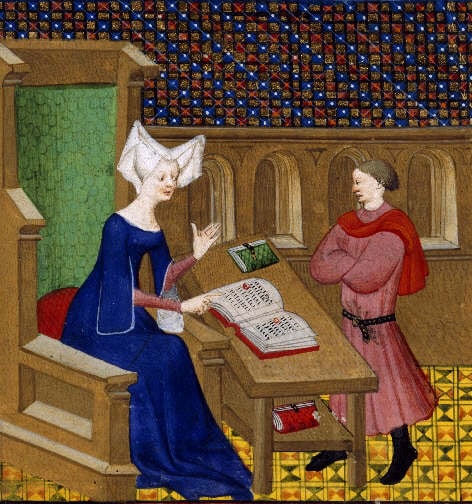
Women that were a part of nobility wore many more layers in comparison to men. You can only imagine how arduous it was for a woman in the Middle Ages to wear daily garments.
These layers would typically consist of underclothes such as breaches, shirts, and a hose covered with underskirts or silk and finished with the final layer that would typically be a long tight gown or a dress.
The dresses were also reflective of the woman’s position in society so excessive ornaments and jewels often made the garments of noblewomen very heavy and hard to wear.
For those who could, jewels and textiles from outside of Europe were an addition to their outfits and a clear indication of power and might.
17. The middle class was, well… somewhere in between.
There was a common characteristic of the middle class in medieval Europe, virtually all over the continent, that reflected in the fact that their clothing was truly positioned somewhere in between the nobility and peasantry.
The middle classes also used some clothing items and fashion trends that were adopted by the peasantry such as wearing wool items but unlike peasantry, they could afford to dye these wool clothing items in green or blue which were more common than red and violet that was mostly reserved for nobility.
The middle class could only dream of purple clothing items in the Middle Ages as purple clothing was strictly reserved for the nobility and the Pope himself.
18. Brooches were very popular in England.
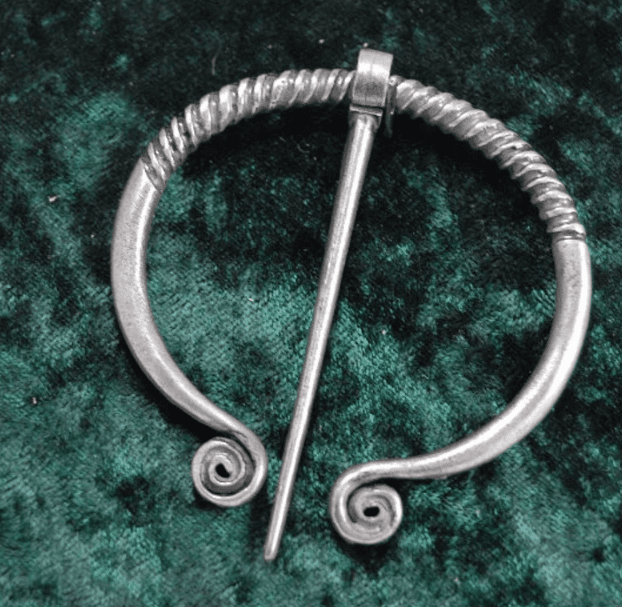
Anglo-Saxons loved wearing brooches. It is hard to find examples of clothing and accessories in which there was so much effort and skill put into like brooches.
They came in all shapes and sizes, from circular to those that were created to look like crosses, animals, and even more abstract pieces. The attention to detail and the material used is what made these pieces stand out and revealed the status of the person wearing them.
It comes as no surprise that they became more detailed and displayed a clear indication of status.
The most beloved brooch was the circular brooch because it was the easiest one to make and offered the most possibilities for decorating. Circular approaches could be enameled with different jewels or decorated with gold.
It was not until the 6th century that metal workers in England started developing their own very distinct styles and techniques which created an entire movement in fashioning brooches and positioned England on the map of brooch making.
19. Elaborate headdresses were a status symbol.
The nobility truly did everything it could to visually distinguish themselves from other classes in society.
One of the more popular clothing items that served that purpose was a headdress that was made out of cloth or fabric that was shaped with wires into specific shapes.
This use of wire led to the development of pointed caps that became highly elaborate over time. There is an entire history of societal relations that can be seen in these pointed hats and the divisions between the rich and the poor are so clearly visible in the style of headdresses.
For nobility, owning a headdress was a matter of convenience while the poor could only dream of affording anything more than a simple cloth over their head or neck.
20. English laws in the 14th century banned the lower classes from wearing long garments.
While today we might have the freedom to choose and wear whatever we want, in the Middle Ages, especially in 14-century England, this was not the case.
The famous Sumptuary Law of 1327 banned the lowest class from wearing long gowns and reserved this for those of higher status.
While unofficial, it was also highly frowned upon to encourage servants to wear cloaks so as not to distract in any way from their masters.
Wrapping Up
The fashion in the Middle Ages is not a fashion of one century, it is a fashion of many centuries that developed into many distinctive styles. Fashion displayed social tensions, changes, and class relations and we can easily observe these in the subtle hints that medieval clothing shows us.
Europe was also not the very center of the fashion world. Although many styles and trends developed here, if it were not for the colors and textiles imported from abroad, the fashion trends would have been less interesting and distinctive.
While some fashion statements of the Middle Ages might not make much sense to us in the 21st century or they might even seem impractical, they still give us an honest insight into a rich tapestry of a life that is sometimes best understood through colors, textiles, and shapes.





